Learn How To Write For Social Media To Create The Best Posts
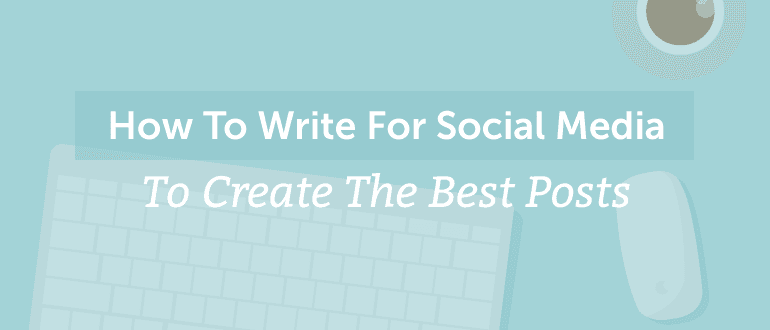 Social media success requires strong writing skills.
However, not all social media managers consider themselves writers.
Fortunately, writing great social media content doesn’t have to be difficult. Not every post needs to reinvent the copywriting wheel, after all. Still, taking the time to get your writing right is worth it.
Let's learn how to write for social media and start creating better content now.
Social media success requires strong writing skills.
However, not all social media managers consider themselves writers.
Fortunately, writing great social media content doesn’t have to be difficult. Not every post needs to reinvent the copywriting wheel, after all. Still, taking the time to get your writing right is worth it.
Let's learn how to write for social media and start creating better content now.
Why Does It Matter If You Write Well On Social Media?
Every social post you publish reflects on your brand. If you’re sloppy, your company will look sloppy too. Even worse, it could undermine your success on social media. That's why it's important to write well on social media. Social media copywriting requires some unique skills. You need to be able to cram as much value into as few words as possible. You also have to be consistent and engaging at all times. Plus, every network is unique. What works on Facebook might flop on LinkedIn. This makes becoming a master social wordsmith even more difficult. And that's exactly why we wrote this post.How To Write For Social Media To Create The Best Posts
Click To TweetSet Yourself Up For Social Media Success
Drafting great message copy directly impacts results, but there are many other factors that can influence your performance on social media. If you want to learn crucial skills & best practices for design, video, images, copy, goal setting, publishing, and so much more, check out Actionable Marketing Institute’s Social Media Strategy Certification course. Become a Certified Social Media Strategist. Gain access to 11 video tutorials, 7 premium templates, and other exclusive content that will guide you through creating a results-driven social strategy.Consistency Counts (So Build A Social Media Style Guide)
Keeping your social copy clean and within brand standards can be a challenge. Developing a simple style guide can help with this. A basic style guide can be one or two pages long, and should include the following:- Mission Statement: This can be twofold: why does your business exist, and why are you on social media?
- Audience/Persona Summary: Briefly describe your core audience on social media. Who are you writing for, anyway?
- Social Media Brand Voice: Describe what your social brand voice should sound like (casual, serious, professional, irreverent, etc.).
- Tone: Describe your social tone (helpful, funny, authoritative, etc.)
- Branding: List requirements for brand spellings (and other copy-related branding elements).
- Message Types (By Network): Not all content needs to go on every network. Create some guidelines on which types of messaging are appropriate on which of your social networks.
Put Together a Social Media Writing Toolbox
The first thing you'll need is the Social Message Optimizer! It's the latest FREE tool from your friends at CoSchedule. ? The Social Message Optimizer helps you nail the mechanics behind writing amazing social media messages. That means it analyzes your message type, character length, number of hashtags, emoji count, and more to help you optimize the perfect message for every social network! When you use the Social Message Optimizer, you'll:
When you use the Social Message Optimizer, you'll:
- Stop guessing what works (and what doesn't). Learning and then remembering all of the best practices for writing on every social network is super time-consuming and tedious. Now you have a clear place to start writing every social media message! Just write, review your score on each network, and optimize further based on real data.
- Get immediate feedback to improve quickly. Consider the Social Message Optimizer your expert who is always there to answer your questions. You'll A/B test your messages before you publish them to get the most engagement on each network.
- Get even more engagement than ever before. Capture more eyeballs with your messages! Get more likes, comments, shares, and link clicks by using the data from 6,399,322 social messages to refine yours to be among the top 10%.
Grammarly
We've all published a social post with a typo before. And we've all felt like this as a result: This is where Grammarly's free browser extension (available for Chrome, Firefox, and Safari) comes in handy. It's a life-saving spelling and grammar checking tool.
Install it on your browser, and it'll check your spelling and grammar on everything you write, anywhere (including on social media).
This is where Grammarly's free browser extension (available for Chrome, Firefox, and Safari) comes in handy. It's a life-saving spelling and grammar checking tool.
Install it on your browser, and it'll check your spelling and grammar on everything you write, anywhere (including on social media).
Hashtagify.me
Looking for relevant hashtags to incorporate into your tweets? Hashtagify.me should fit the bill. It's an easy-to-use hashtag search engine to help you find hashtags people are actually using.9 Basic Social Media Writing Tips
Like we said earlier, every network has its own quirks and best practices. However, there are some standard best practices that generally apply to most networks, too. Let's review those now.Start writing better on social media now.
Click To TweetUnderstand Active Vs. Passive Voice
Using active voice helps produce more engaging copy. According to PlainLanguage.gov,Readers prefer active voice sentences, and we should try to use the active voice in most of our business writing to communicate our message most effectively. Active voice clearly identifies the action and who is performing that action.Most writers are familiar with active and passive voice. If you’re not sure what the difference is (and were afraid to ask) though, then never fear. There’s no shame here. Let’s walk through each one:
 Hear the difference? The first example puts the subject (“I”) in the driver’s seat. It’s more action-oriented. The second example, however, sounds a bit more flat, factual, and lacking action.
Hear the difference? The first example puts the subject (“I”) in the driver’s seat. It’s more action-oriented. The second example, however, sounds a bit more flat, factual, and lacking action.
Writing for social media? Use active voice.
Click To TweetPut Your Audience First
It's rude to only talk about yourself. So, write in a way that puts your audience at the center of the story instead. How do you do this? Simple. Say “you” more than you say “us.” Here’s a good example from Threadless’ Twitter bio:
Write Stuff People Want To Share
This requires understanding why people share content. Let's break this down into five major reasons: Delivering value to their audience. People want to share things their audience will find valuable. This could mean content that’s helpful, entertaining, or otherwise worth paying attention to. Try writing posts that convey a clear benefit. If you create how-to content, consider writing copy that hints at what the linked article will help readers do. You can also create unlinked social messages that include a useful tip in your post copy or image copy. Here’s an example from Bobcat Company: To express and define themselves. When sharing posts, people often think, “How does sharing this reinforce my identity?”
Use surveys or create personas to understand your typical audience member. From there, figure out how they identify themselves. For example, if you sell construction equipment, your audience might see themselves as “tough” or “hard-working.”
Pickup truck manufacturers know their customers connect their identities to what they drive. This post from Ram Trucks capitalizes on this:
To express and define themselves. When sharing posts, people often think, “How does sharing this reinforce my identity?”
Use surveys or create personas to understand your typical audience member. From there, figure out how they identify themselves. For example, if you sell construction equipment, your audience might see themselves as “tough” or “hard-working.”
Pickup truck manufacturers know their customers connect their identities to what they drive. This post from Ram Trucks capitalizes on this:
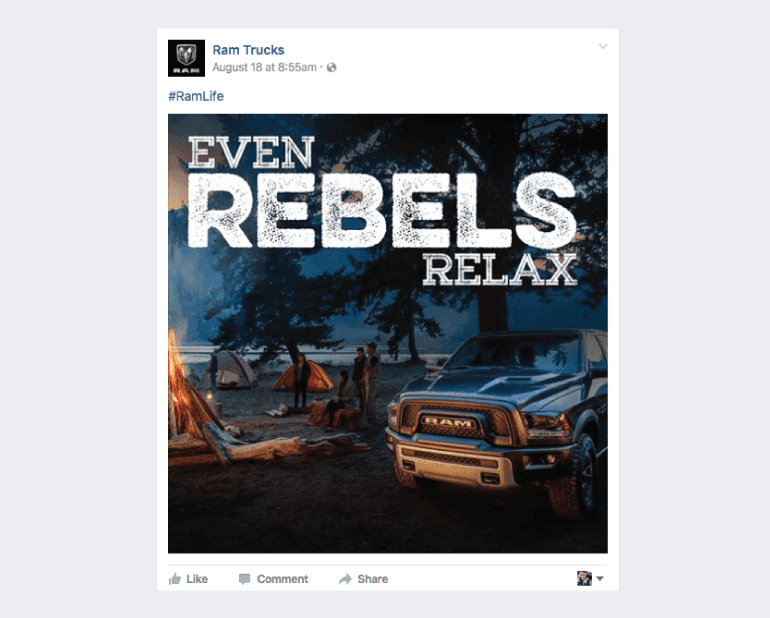 To feel connected to others. Social media is about building connections and relationships. People naturally want to share posts that shows they’re part of something bigger themselves. They also like to share posts likely to start a conversation (so they can converse with other people).
One way to do this is to write messages that encourage tagging and sharing. Like this:
To feel connected to others. Social media is about building connections and relationships. People naturally want to share posts that shows they’re part of something bigger themselves. They also like to share posts likely to start a conversation (so they can converse with other people).
One way to do this is to write messages that encourage tagging and sharing. Like this:
 To make themselves feel valued. People want to share posts that are likely to get likes, shares, and positive comments. It feels good to share something your friends like, right? You might also consider writing messages showing appreciation for your audience.
To express beliefs or support causes. People love sharing opinions on social media. You probably don't need to be told that, either.
If it’s appropriate, take a stance on something or show your support for a cause. You don’t have to get too controversial (although sometimes a little bit of controversy is okay). Here’s an example from the United Nations:
To make themselves feel valued. People want to share posts that are likely to get likes, shares, and positive comments. It feels good to share something your friends like, right? You might also consider writing messages showing appreciation for your audience.
To express beliefs or support causes. People love sharing opinions on social media. You probably don't need to be told that, either.
If it’s appropriate, take a stance on something or show your support for a cause. You don’t have to get too controversial (although sometimes a little bit of controversy is okay). Here’s an example from the United Nations:
 This tweet does each of the following:
This tweet does each of the following:
- It promotes a cause (gender equality).
- It incorporates a relevant hashtag in the middle of the tweet.
- It uses positive language.
- It links to a page where viewers can take action.
Before writing social posts, ask 'Why would someone share this'?
Click To TweetMake Sure You Have Clear Message-Match Between Your Posts And Destination Pages
If your post is linking to an external page, then your post messaging needs to match your landing page messaging. In short, your social media content needs to follow through on the promises your posts make. Here are a few tips to keep in mind:- Double-check that links are accurate.
- Only link to substantive pages with good information.
- And make sure your post copy is relevant to your destination page.
 Who knows? I don't, but the destination page here better tell me.
Who knows? I don't, but the destination page here better tell me.
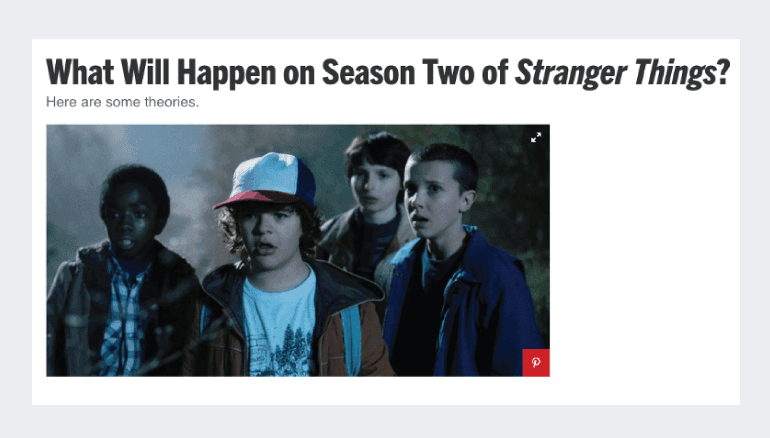 Once I reach the page, it’s immediately clear that the post copy directed me to a relevant link. The destination page’s headline is well aligned with the tweet, too. That’s a good thing, because if this ended up being click bait, I would have thrown my keyboard.
Once I reach the page, it’s immediately clear that the post copy directed me to a relevant link. The destination page’s headline is well aligned with the tweet, too. That’s a good thing, because if this ended up being click bait, I would have thrown my keyboard.
Make sure your social messaging matches your destination page.
Click To TweetMake Sure Your Copy Matches Your Visual Content, Too
If you’re writing image copy, consider connecting it with your post copy too. Here’s a great example from Gary Vaynerchuk: See how the post copy connects with the image copy? One leads into the other to communicate one clear message.
Here’s another example from the NFL that creatively incorporates a player’s number (in this case, Randall Cobb of the Green Bay Packers, the greatest sports franchise in history*):
See how the post copy connects with the image copy? One leads into the other to communicate one clear message.
Here’s another example from the NFL that creatively incorporates a player’s number (in this case, Randall Cobb of the Green Bay Packers, the greatest sports franchise in history*):
 *Your favorite team is great, too.
This creative campaign counted down the days until kickoff, including a different player down to opening day.
*Your favorite team is great, too.
This creative campaign counted down the days until kickoff, including a different player down to opening day.

Be Clear And Concise
Avoid complex language and use short sentences. People skim on social media, so punchy posts tend to work better than long-winded paragraphs. Try to limit yourself to just one or two sentences, if possible. This isn’t a firm rule, but it may be a useful guideline to keep yourself from rambling. Struggling to keep your posts short? Try working through this simple exercise. Start by reading this example post: “Here is our latest blog post about a very awesome topic you’ll enjoy.” This isn’t that bad, right? Well, there are a lot of wasted words we could do without. Let’s try minimizing stop words (is, a, etc.) and see how it sounds. We could also make the end of the sentence more specific, focusing on one detail to use fewer words. “Here’s our latest blog post about blogging.” Hear the difference? The second example says essentially the same thing. It just does it with fewer but more specific words, and sounds much better as a result.Clarity and conciseness are key for writing well on social media.
Click To TweetAvoid Pushy, Overly Sales-Driven Messaging
At least when it comes to writing organic social media content. While social ads need to be written to sell, organic social posts should be written to inform, entertain, or otherwise make a connection with your audience. That doesn’t mean you can’t promote yourself. It just means it’s best to find a way to sell people on the idea of taking an action without directly sounding like you’re making a sales pitch. Here’s an example from music distribution platform Bandcamp: If you must write a sales message, focus on benefits to the consumer. This tweet from Threadless lets people know there’s a sale going on without forcefully saying, “Buy Now” or “Shop Here.” It also uses a nice, clear image.
If you must write a sales message, focus on benefits to the consumer. This tweet from Threadless lets people know there’s a sale going on without forcefully saying, “Buy Now” or “Shop Here.” It also uses a nice, clear image.

Invoke Curiosity
Write in a way that makes people want to click through. If you’re linking to another article or blog post, you don’t need to tell the whole story in your social media update. Instead, leave some details unanswered while implying your linked articles will answer their questions. What is the mystery on "The Curse of Oak Island," anyway? You don't have to care about construction equipment to want to find out.
Instead, leave some details unanswered while implying your linked articles will answer their questions. What is the mystery on "The Curse of Oak Island," anyway? You don't have to care about construction equipment to want to find out.
Social Media Writing Tips For Each Network
Every social media network is different. Different audiences. Different purposes. Different expectations. Your writing and messaging should be adjusted accordingly. Instead of writing one message for every network, tailor your messaging to each one individually. To do this, it helps to understand the purpose of each network, and what works best on each one: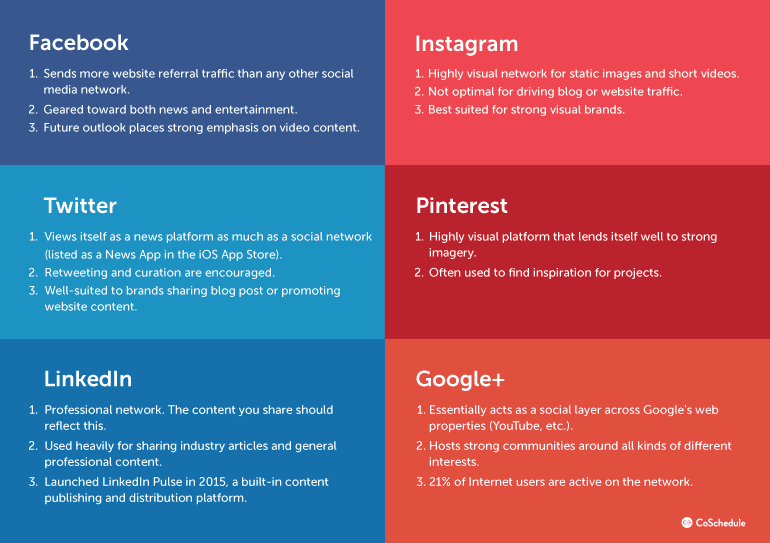
Consider audience expectations for each network when writing social media posts.
Click To TweetFacebook Writing Tips
With declining Facebook organic reach, sharp copy is now more important than ever.Keep Posts Short
There’s some wiggle room on this one. However, data shows short posts perform best.Avoid Promotional Calls-To-Action
Facebook’s algorithm can detect overly promotional language. This means wording like, “Buy Now!” or “Sign up here!” Posts with a hard sales message get demoted in the newsfeed, and with organic reach already in decline, that’s something you can’t afford.Write Shareable Article Headlines
If you’re writing blog posts or articles, keep Facebook in mind when crafting catchy headlines. Think short, punchy, and conversational.Twitter Writing Tips
You can do a surprising amount with just 140 characters. Here are some tips to make the most of your tweets.Do More Than Simply Reshare Headlines As Post Copy
This one is okay in moderation. However, it’s better to write copy that adds to the story your article is telling. Here’s an example of what we mean: Instead of reusing the article headline as a social post, the post outlines the story in the article. This helps build interest in clicking the link, and prevents wasting people’s time reading the same text twice.
Instead of reusing the article headline as a social post, the post outlines the story in the article. This helps build interest in clicking the link, and prevents wasting people’s time reading the same text twice.
Incorporate Hashtags Directly In Tweet Copy
It’s easy to add hashtags to the end of a post. However, consider cleverly incorporating them directly into your tweets instead. In this example from Electronic Arts, a single hashtag is the entire post. This creates a clean look for your hashtags, and ensures they get seen.
This creates a clean look for your hashtags, and ensures they get seen.
Get creative and directly incorporate hashtags in your social posts.
Click To TweetGo Easy On Hashtags, Though
Make sure your message isn’t lost in a sea of hashtags. Aim to use two, or maybe three, at the most.Be Mindful Of Your Character Limit
You have 140 characters here. Stay under that limit without cutting corners. Conciseness is no excuse for lack of clarity.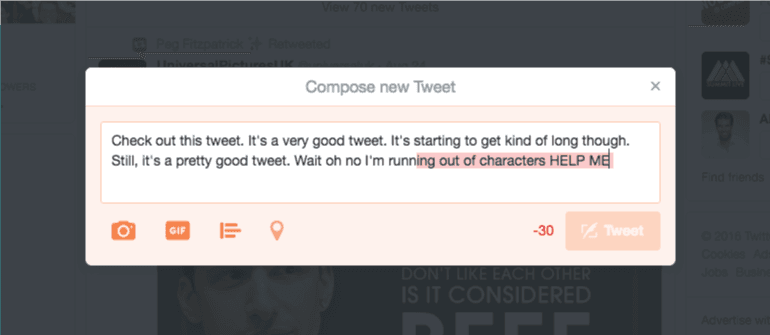 If you can’t use complete sentences, you need to rewrite your tweet.
If you can’t use complete sentences, you need to rewrite your tweet.
Try Adding URLs In The Middle Of Tweets (Instead Of At The End)
This tip comes from Dan Zarrella at Hubspot. This data is a little old at this point, but in 2011, he discovered that “the best area for clicks is about 25% of the way through the Tweet.” As a writer, testing this requires you to consider writing in a way that would let you place a link after just two or three words. Try following this formula: [Short Intro] + [URL] + [Longer Explanation].Have you tried putting URLs in the middle of tweets, instead of at the end?
Click To TweetTag Other Relevant Accounts Within Your Tweet Copy
This helps alert other folks that you’re talking about them. In turn, they’ll be more likely to share your posts. It’s win-win. Be sure to write your posts with other accounts in mind.Incorporate Emojis Into Your Tweet Copy
Like it or not, “emoji” is turning into a language all its own. Used creatively, they can add a splash of character to your tweets. Check out this example from Sporting Kansas City, a Major League Soccer team:
Tell A Story In A Tweet
It’s possible to tell a complete story in a tweet. Here’s an example from Microsoft: This tweet outlines the entire article in under 140 characters.
This tweet outlines the entire article in under 140 characters.
Google+ Writing Tips
Google+ is different from other social networks and allows for some interesting formatting options. Use that to your advantage.Write Compelling Post Headlines
Google+ is unique in that it allows you to write bolded headlines. General best practices for writing headlines applies here.Don’t Be Afraid To Tell A Whole Story
Google+ posts can run a bit longer than on other networks. Take advantage of that. Go into more detail than normal if you feel you need to.LinkedIn Writing Tips
LinkedIn is a professional network. Here's how to make sure your writing reflects that.Be Clear
Avoid using professional lingo if it won’t be understood by your audience.Be Concise
Get to the point. Don’t ramble. Busy professionals don’t have time to waste.Stay Professional
LinkedIn is a professional network. Don’t forget this when writing your posts. Stick to a professional tone.Instagram Writing Tips
Instagram is a visual-driven network. However, the written word still has its place there.Think About Alignment Between Your Image Copy And Post Copy
Instagram is a visual network, but the written word still has a place there. Write image copy that hooks people’s attention while connecting with your post text.
Don’t Forget Hashtags
Instagram likes hashtags. Don’t be afraid to use them liberally at the end of your posts.Pinterest Writing Tips
Pinterest is a highly visual network, but that doesn't mean you can neglect your writing chops here.Write Longer Pin Descriptions
According to a study from Dan Zarrella, descriptions over 200 characters long received more repins. That could be thanks to those pins having more detailed context around what they're about to entice people to click and share.Include Links in Pin Descriptions
If people like the images you pin, they'll probably want to learn more about where they came from. Adding a link helps, and don't be afraid to add a call to action, either.Include Relevant Keywords in Your Pin Descriptions
Including keywords in pin descriptions can help them show up in searches on Pinterest.How To Define And Develop Your Voice And Tone
People expect social media accounts to have a consistent voice. Your presence needs personality, even if you’re representing a brand. Social media is about generating conversation. No one wants to talk to someone boring. This means you’ll need to develop a consistent voice. One that’s both true to your brand or personality, while fitting for each social network you’re on.What Does Your Social Media Voice Sound Like?
Your voice is essentially your personality on social media. Are you fun? Serious? Creative?What's The Difference Between Voice And Tone?
Voice and tone are often used interchangeably. However, there is a difference, and it's important to understand them both. Your tone is the inflection you apply to your voice. Depending on the context, you could sound happy, sad, angry, or any other emotion that's appropriate. Buffer's Kevan Lee may have put it best:Essentially, there is one voice for your brand and many tones that refine that voice. Voice is a mission statement. Tone is the application of that mission.

How To Develop Your Brand's Social Media Personality
Start by asking these questions:- What is my/our mission or purpose?
- What are our values?
- What kind of language and tone does our audience use?
Are You Personable? Professional? Or Both?
 Social media is often used to keep in touch with friends, family, and colleagues.
That means your social media content has to compete against updates from people users are close with. It's a simple fact that most people don’t log into a social network to see content from brands, companies, or bloggers.
There are exceptions, of course. In any case, you need to write to stand out and hook people’s attention. This requires understanding what your audience expects to see from you.
And that might be hard if your brand isn’t inherently “fun.”
So, what can you do?
Social media is often used to keep in touch with friends, family, and colleagues.
That means your social media content has to compete against updates from people users are close with. It's a simple fact that most people don’t log into a social network to see content from brands, companies, or bloggers.
There are exceptions, of course. In any case, you need to write to stand out and hook people’s attention. This requires understanding what your audience expects to see from you.
And that might be hard if your brand isn’t inherently “fun.”
So, what can you do?
Know Your Audience
Who are your customers? What are their values, concerns, and interests? It’s important to figure this out if you don’t already know. Survey your audience if you have to. You need to know who you’re writing for before you can understand what they want from you. Creating a social media audience persona might help. This essentially entails creating a character description of your average target audience member. Building personas takes a little bit of work, but it can help you get a clear idea of who you’re writing for.Know Your Competition
Seeing what kind of content your competition is writing can help inspire your own approach. Check out some of your competitor’s social profiles and make note of the following:- What does their brand voice sound like?
- Does their content appear to drive engagement?
- If this company were a person, would I want to talk to them?
 This can give you an idea of what works in your industry.
This can give you an idea of what works in your industry.
Know Yourself.
Cat videos, memes, and other distractions dominate on social media. Those things might work for your brand. They could also be totally inappropriate. The key is to find the right balance between personable and professional content and tone for your audience. Start by defining yourself under one of these three categories:- Personable. Your brand is fun, warm, and inviting.
- Professional. Your brand is serious, authoritative, and orderly.
- Both. Your brand bridges both of the above, tying fun content into more professional themes.
Exercise 1: Determine Who You Are (By Determining Who You’re Not)
One way to help understand your brand voice is to ask “We are ______ , but we are not ______ “ questions. This can help you know who you are, and just as importantly, who you’re not. As an exercise, fill in those blanks a few different ways. Here are some examples: “We're fun, but we’re not goofy.” “We're informative, but we’re not boring.” “We're authoritative, but we’re not arrogant.”Exercise 2: Try Summarizing Your Brand In Just Three Adjectives
Another idea is to simply think of three adjectives that describe your brand. In traditional advertising parlance, this could be thought of as a “tag line.” According to The Balance,A variant of a branding slogan, a tagline can be used in marketing materials and advertising. The idea behind the concept is to create a memorable dramatic phrase that will sum up the tone and premise of an audio/visual product, or to reinforce and strengthen the audience's memory of a literary product.Your mission (should you choose to accept it), is to do one of the following:
- Keep your company’s existing tag line in mind when writing on social media. Ask yourself, “How does this messaging support or reflect what we’re about?”
- Come up with a new tagline. It doesn’t have to be one you use publicly. It could even just a short phrase you use internally to guide your copy.
- An adjective describing what you do.
- Another addressing how you do it.
- One more pertaining to why you do it.
- Honesty
- Experience
- Quality service
Summarize your social brand in three adjectives.
Click To TweetExercise 3: Try Different Things And See What Works
This is the simplest option. If you’re not sure what kind of voice would resonate with your audience, try different things. Try writing something humorous. Then, try something more serious. Keep an eye on what gets engagement. Pretty simple.3 Examples Of Fun Social Media Brands
A lot of this stuff might sound kind of abstract. So, let’s take a look at what personable and professional content looks like on social media.BarkBox
Barkbox, a subscription-box service for dog owners, does an incredible job at creating fun social media content. They’re relatable, light-hearted, and creative.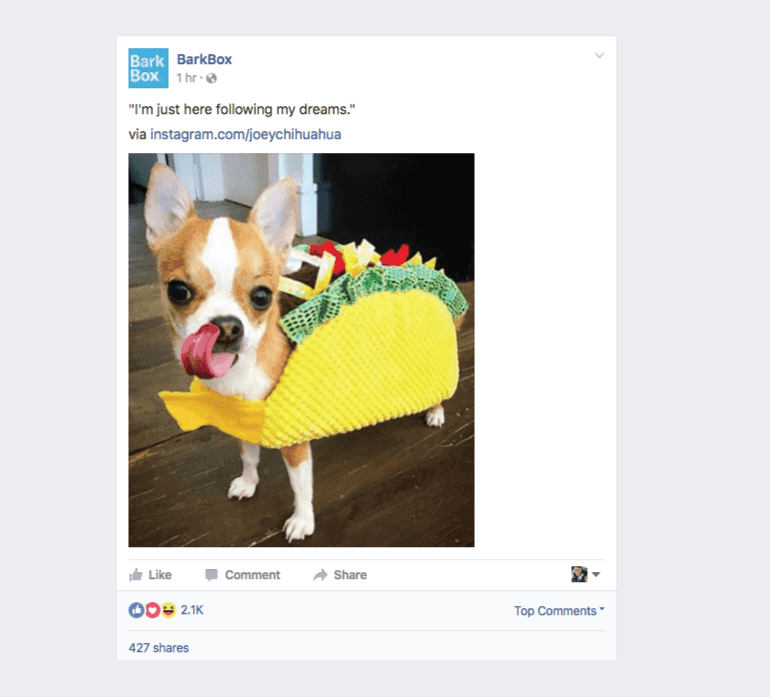
Arby’s
Arby’s does a fantastic job of writing posts that target specific segments of their audience. Here’s just one example:
Threadless
Threadless, a custom clothing and home decor company, balances creativity with promotional copy well. This tweet does a good job of alluding to their blog without directly saying, “HEY READ THIS THING OVER HERE RIGHT NOW”: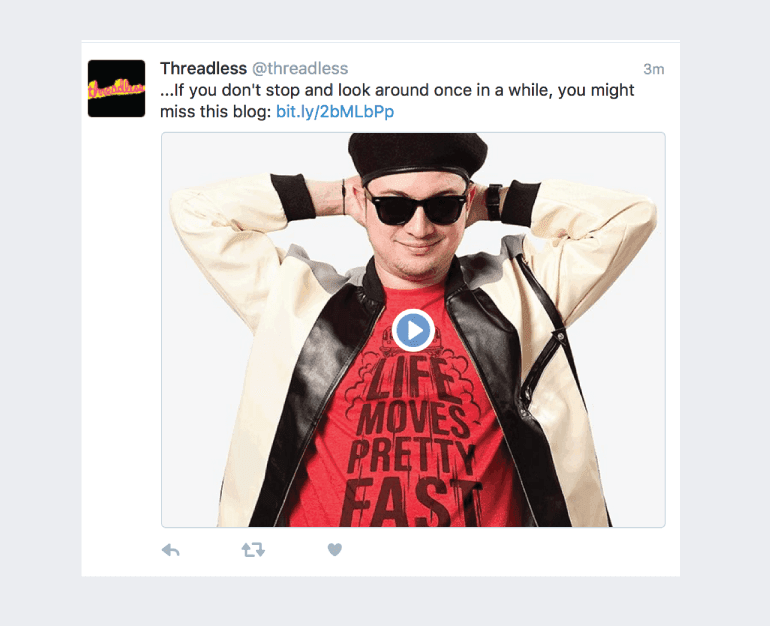
3 Examples Of Serious Social Media Brands
If your brand offers professional services, or if you’re in a more “traditional” industry (for lack of a better term), then “fun” or “personable” might not suit your voice. Instead, you might strive to sound authoritative. Or, maybe you just want to present a more polished image. With some slick copywriting flair, you can achieve this goal, and without being boring. Here are three brands that prove it.General Electric
For a brand that’s over 100 years old, General Electric has an incredible social media presence. Just check out this social media hub page: Their content is typically educational while making engineering and technology sound interesting, even to a non-technical audience. Here’s an example of GE taking a technical topic (robotics) and making it accessible to a lay audience:
Their content is typically educational while making engineering and technology sound interesting, even to a non-technical audience. Here’s an example of GE taking a technical topic (robotics) and making it accessible to a lay audience:

Microsoft
Microsoft products are everywhere, and that probably includes your home and office (or even your home office). Their social media updates speak to both personal and professional customers, tying their products and initiatives back into real-world stories and situations.
Vox
Vox Media is a solid example of a modern media brand that understands social. They use their social post copy to help tell the story in the articles they want to direct you toward. Rather than simply resharing a headline as a post, the post helps tell a complete story. Even when the topic is serious, the tone also remains conversational.
3 Examples Of Brands Blending Personable And Professional Content
What if your audience wants both fun and professional tone? Here are three brands perfectly riding that balance.WordStream
WordStream, a popular PPC management software service, does an excellent job of incorporating fun imagery with professional copy. Check out this example:
 This post does three things:
This post does three things:
- It ties in directly to a professional theme.
- It ties in directly to a timely trend.
- It’s funny.
- Their voice and mission (connecting professionals)
- The purpose of those other networks they’re on
You Have The Tools To Write, Now Execute
Now it’s time to take the writing tips you’ve learned & upgrade your social messages. Then if you’re ready, you can level up your social 10x more with AMI’s Social Media Strategy Certification course.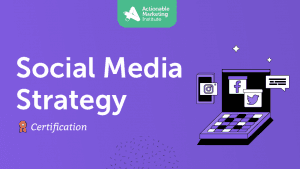 Develop a social strategy that grows your traffic, leads, & community.
This post was originally published on Oct. 3rd, 2016. It was updated and republished on April 19th, 2017.
Develop a social strategy that grows your traffic, leads, & community.
This post was originally published on Oct. 3rd, 2016. It was updated and republished on April 19th, 2017.

